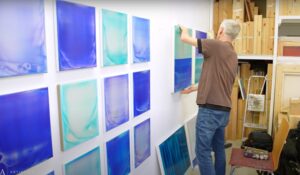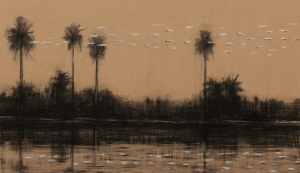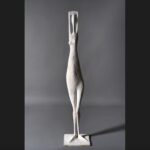Three of the gallery’s artists derive their pictorial and/or philosophical resources from calligraphy, a major art-form from the Far East and source of all other forms of expression. In this series of 3 articles we have asked each artist about the origin and the nature of this influence. Today: Lumi Mizutani.

Untitled I (2013), Calligraphies series, Lumi Mizutani. India ink on Japanese paper, 50 x 54 cm.
Born in Nagoya, Japan, Lumi Mizutani moved to France in the middle of the 1970s and trained in lithography, which constitutes the bulk of her artistic practice up until the beginning of the 2000s. At which time she undertook a “brush-up course working with ink”, first with a Chinese master, then with a Japanese master. The almost infinite possibilities that the conversation offers between these three elements (ink, water and paper) opened up new avenues that Lumi Mizutani has not stopped exploring since : “I let myself be led by its whims, by this substance which floats on, penetrates and then devours the support” she says commenting on her works in China ink on paper.
Apart from traditional techniques, Lumi Mizutani uses tools and techniques that she has developed herself, like an elastic band that is dunked in the China ink. Her series “Calligraphies” shows off this experimental technique to a great extent : “Some masters cannot be outdone. Therefore you’ve got to find other things that they don’t know or don’t use.”
One of your series is called “Calligraphies”. Can you tell us a bit about this project: when you began it and what is behind the series?
I started this project about 10 years ago, following an intense period of work on nature, with ink. I had a urge for even more liberty, and that is what led me to create my abstract works.


Left: Music (2013), Calligraphies series, Lumi Mizutani. Ink on Japanese paper, 50 x 35 cm.
Right: Reversible (2013), Calligraphies series, Lumi Mizutani. Ink on Japanese paper, 50 x 41 cm.
For the different works of this series you didn’t use a brush, but objects/ tools having nothing to do with traditional calligraphy. Why?
Traditional calligraphy is intended for drawing letters. While this is very interesting it is not really the purpose of my painting. But I got the idea of starting there and trying to find another form of painting, in a sort of calligraphic way.
What i’m looking for, is free expression which reaches out from the body to infinity, well beyond the place defined by the leaves that make up the medium. It is this undoubtedly philosophical desire which is behind this work.
Besides this series, is Japanese calligraphy generally a part of your work?
Yes, the influence it has is very simple : it’s not just a question of painting with a brush, one puts the whole body into it.
To find out more about Lumi Mizutani :
> View our video interview in her Parisian workshop
> View all her works for sale on Artistics
In the same series:
> Calligraphy and contemporary art : 3 questions for Hachiro Kanno
> Calligraphy and contemporary art : 3 questions for Zhang Hongyu






